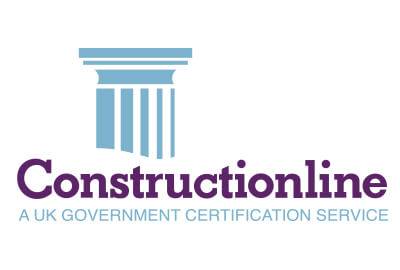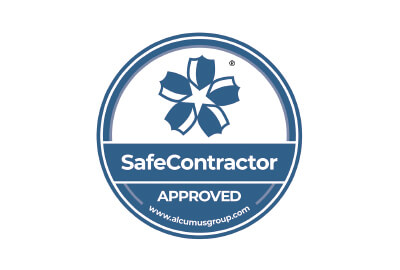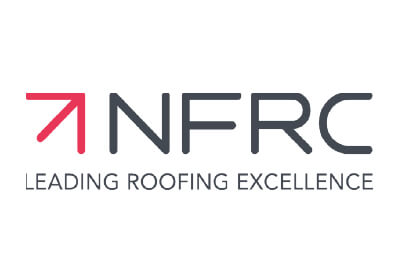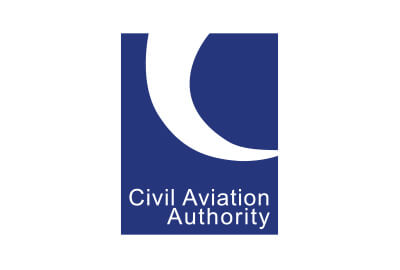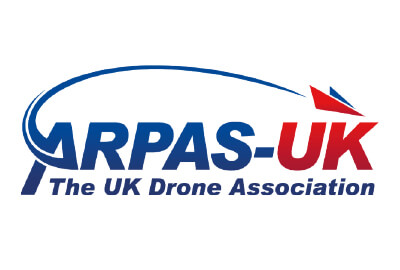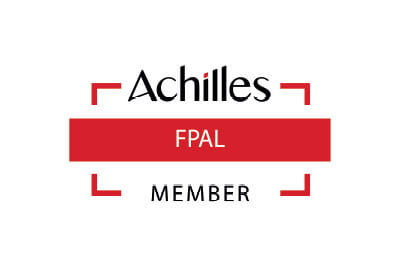Winter can be one of the most demanding times for a building’s fabric and systems. The combination of colder temperatures, rain, snow, freeze-thaw cycles, wind and falling leaves means that what might be a minor issue in summer can become a major repair job in spring. To help you stay ahead of costly downtime, damage or disruption, this blog outlines essential building maintenance, gutter cleaning and chimney repair tips, tailored for both commercial building maintenance and domestic property owners across the UK.
And how a professional like Balmore Specialist, whether you’re after industrial rope access Glasgow, a commercial roofer Glasgow or a local gutter cleaning service.
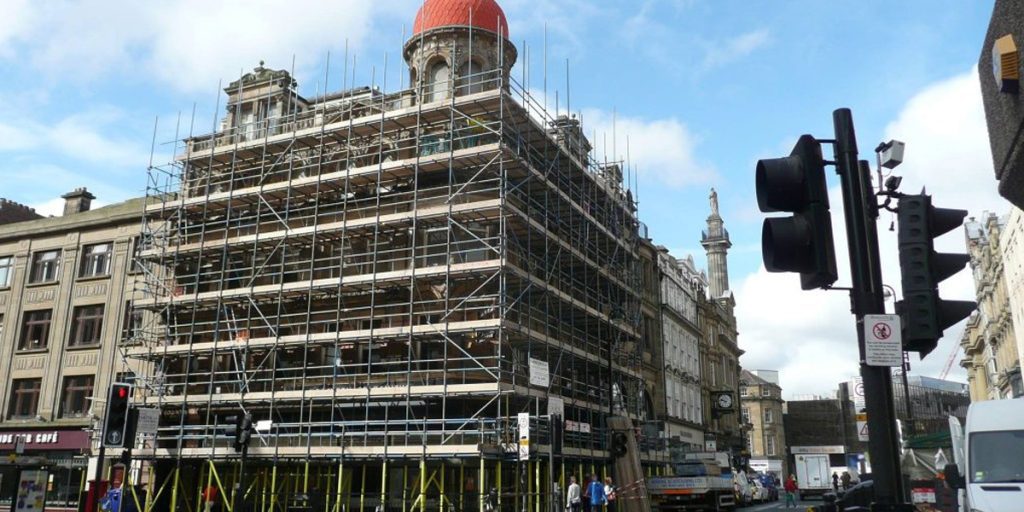
Building Maintenance: The Big Picture
“Building maintenance” refers to all the planned and reactive work needed to keep a building safe, functional and durable. This includes everything from roof and facade integrity, gutter and drainage systems, HVAC or ventilation systems, to internal components like doors, windows and heat systems. In the commercial context, this is often referred to as facility maintenance or commercial building maintenance.
What is the purpose of building maintenance?
- Preventing small faults from turning into major repairs (planned preventative maintenance)
- Ensuring occupant comfort and safety
- Minimising downtime or business disruption
- Reducing the whole-life cost of the building by keeping it in good condition
Types of Building Maintenance
- Planned & Preventive Maintenance (PPM): Scheduled inspections, servicing of HVAC, roof checks, waterproofing, etc.
- Reactive maintenance/building repairs and maintenance: Fixing leaks, responding to storm damage, and replacing worn parts.
- Commercial building maintenance/facility maintenance: Especially for offices, industrial units, retail, broader scope including services, systems, structural elements.
- Building maintenance contractors: The specialist trades you call in (roofers, gutter cleaners, rope access teams) to execute works safely.
Benefits of Building Maintenance
- Extends the life of the building envelope and systems.
- Improves energy efficiency (less heat loss, fewer drafts).
- Reduces risk of business-critical failure (e.g., roof leak, freeze burst).
- Improves occupant comfort & safety (fewer hazards).
- Helps maintain building value and avoids surprise costs.
Best Practices for Winter-Ready Building Maintenance
- Conduct an audit of the building envelope before the cold sets in (roofs, walls, glazing, insulation); freeze-thaw cycles can worsen tiny cracks.
- Schedule inspections of critical systems (HVAC, heating, ventilation) so they’re ready for winter loads.
- Clear drainage paths and check roof drainage, gutters, and downpipes for blockages.
- Ensure building joints, sealants, flashing, and mortar are intact. Winter weather magnifies defects.
- Keep good records of maintenance, especially for commercial maintenance plans, to ensure compliance and budgeting.
- Engage reputable building maintenance contractors (especially for work at height/rope access) rather than waiting for failure.
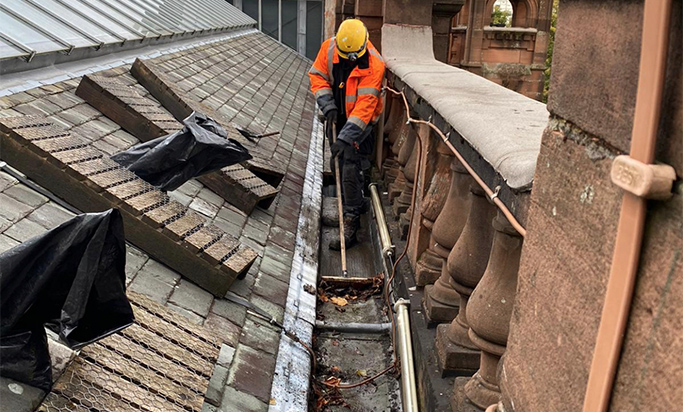
Gutter Cleaning & Winter Drainage Maintenance
Proper gutter cleaning is a highly important subset of building maintenance, especially heading into winter. Neglect gutters and drainage, and you risk ice dams, water ingress, roof damage, foundations and downpipe failure.
How to prepare gutters for winter?
- Clear your gutters of leaves, twigs, moss and debris so that water can freely drain. In practice, this means at least one cleaning in the autumn, so you enter winter with a clear system.
- Inspect gutter brackets, joints, and downpipes, and fix any misalignment. Solidly fixed gutters help withstand snow/ice loads.
- Consider installing or checking gutter guards or protection systems, particularly in high-tree areas. They help prevent debris build-up and freezing.
- Ensure downpipes discharge clear of building foundations and into properly graded drainage to avoid pooling or freeze risk at the base.
- After heavy rainfall, inspect and flush the gutter system to ensure it is flowing properly. Some downpipes may have been blocked over the summer.
When is the best time of year to have your gutters cleaned?
- Most expert guidance recommends twice-a-year cleaning: once in the autumn (before leaves fall) and again in the spring (after winter debris).
For the UK (or Scotland), you might target:
- Late autumn (October/November), to clear leaves and get ready for winter precipitation and freezing.
- Early spring, to clear winter build-up before heavy spring rains.
Additionally, after major storms or if there are many trees, you may need more frequent cleaning.
Why does this matter in winter?
If gutters are blocked, melting snow or rain can’t escape properly, water backs up under roof tiles or fascia, freeze-thaw cycle cracks joints or tiles, leaks, or collapses.
Similarly, blocked downpipes mean water sits, can freeze, add weight and cause structural stress. Proper drainage is a key part of building maintenance.

Chimney Repairs: Winter Focus
Within the building maintenance scope, chimney repairs often get overlooked until a fault becomes urgent. But especially in winter, when you might rely on your fireplace or heating, chimney defects can matter for safety, efficiency and building integrity.
How to prepare chimneys for winter?
- Schedule an inspection and (if needed) cleaning of the chimney flue before heavy use begins. Professionals recommend at least annually.
- Inspect the chimney crown, flashing around the chimney and ensure the chimney cap is fitted and intact. These help prevent water ingress and blockages from birds/debris.
- Check for visible signs of damage: missing bricks, cracked mortar, loose flue liner, and signs of water staining inside. These are pointers to required chimney repairs.
- Ensure the damper operates correctly (opens/closes) to prevent draughts and heat loss during non-use.
- If you burn wood, ensure the chimney has been swept to remove creosote build-up, which is a fire hazard.
How often do chimneys need to be repaired?
- The frequency of chimney repairs depends on usage, weather exposure, initial build quality, and material. As a rule:
Sweep/inspect at least once a year. - Structural repairs (such as tuck-pointing, mortar replacement, and crown replacement) may be needed every few years, depending on condition.
If you notice rapid deterioration (water ingress, spalling bricks, frequent leaks), you’ll need repairs sooner.
Can chimney repair be done in winter?
Yes, but with caveats. Masonry repairs done in cold conditions are more difficult because mortar may not cure optimally in freezing temperatures. Experts say “winter chimney repairs are only recommended in emergencies.”
Therefore:
- If damage is minor and you can schedule for warmer months, that is preferable.
- For urgent issues (water leaking, structural risk), a professional with appropriate materials and protection (tarps, heaters) can repair in winter.
As part of your building maintenance plan, consider scheduling such works ahead of time so you’re not caught out mid-winter.
Why Choose Balmore Specialist for Winter Building Maintenance?
At Balmore Specialist Roofing & Property Maintenance, based in Glasgow but serving almost all of the UK, we understand the winter challenges faced by both homeowners and businesses. Whether you need a commercial roofer in Glasgow, industrial rope access in Glasgow, gutter repairs in Glasgow, or general building maintenance services, our team is equipped for the task.
We offer full building maintenance & services: roof inspections, planned preventative maintenance, commercial building maintenance, building repairs and maintenance.
For gutters: we provide gutter cleaning service (commercial or house gutter cleaning), emergency gutter cleaning, rain gutter cleaning cost quotes, industrial gutter cleaning and local gutter cleaning services.
For chimneys: we deliver chimney repairs, roof and chimney repair, winter-ready inspections, and fix flashing or masonry issues.
We operate using safe rope access methods in difficult or high-up locations (rope access in Scotland / industrial rope access in Glasgow), which means less disruption and better access for large commercial buildings.
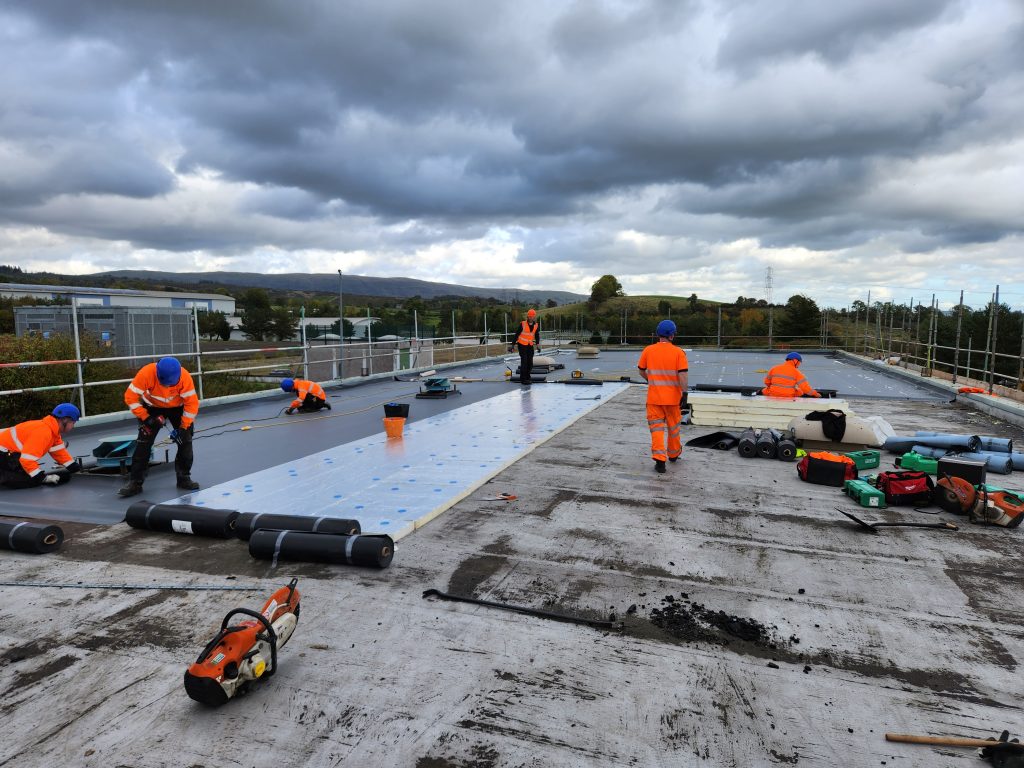
Final Thoughts
Winter building maintenance is proactively about prevention, not just reaction. If you wait until a heavy snow, heavy rain or freeze event reveals a fault, the cost, disruption and risk will likely be much higher. Whether you’re managing a commercial property with facility maintenance contracts, or you’re a homeowner looking for reliable building repairs and maintenance, gutter cleaning and chimney repairs are major pieces of the puzzle.
With the right preparation and trusted maintenance partner, you can sleep easier through the colder months, knowing your roof, gutters, and chimney are up to the challenge.
Ready to get started? Contact Balmore Specialist today for a winter-readiness inspection and quote, and keep your building in top condition.
Be proactive, protect your building this winter.





